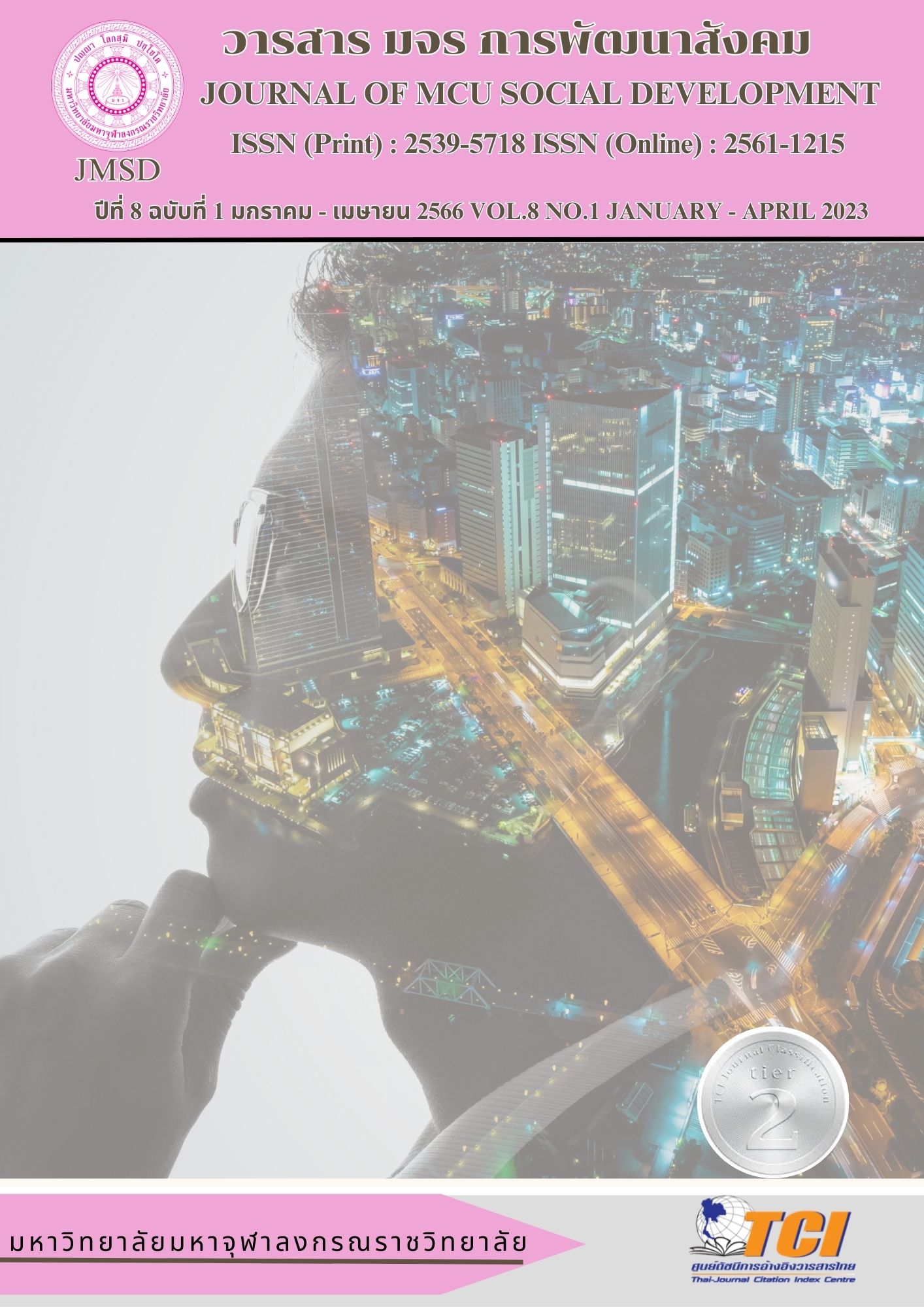ปัจจัยที่มีอิทธิพลต่อความผูกพันของผู้ใช้บริการศูนย์การค้าในยุคดิจิทัล
คำสำคัญ:
ศูนย์การค้า, ความผูกพัน, ยุคดิจิทัลบทคัดย่อ
การวิจัยครั้งนี้มีวัตถุประสงค์ 1) เพื่อศึกษาปัจจัยเชิงสาเหตุที่มีอิทธิพลต่อความผูกพันของผู้ใช้บริการศูนย์การค้าในยุคดิจิทัล 2) เพื่อศึกษาแนวทางการปรับตัวของธุรกิจศูนย์การค้า ในการยกระดับความผูกพันของผู้ใช้บริการศูนย์การค้าในยุคดิจิทัล ใช้วิธีการวิจัยแบบผสมผสาน ในการวิจัยเชิงปริมาณ มีกลุ่มตัวอย่างคือ ผู้ใช้บริการศูนย์การค้าในเขตกรุงเทพมหานครและปริมณฑล ซึ่งมีการใช้บริการในช่วง 3 ปีที่ผ่านมา จำนวน 380 ราย ขนาดของกลุ่มตัวอย่างกำหนดโดยใช้เกณฑ์ 20 เท่าของตัวแปรสังเกต ใช้วิธีการสุ่มตัวอย่างแบบชั้นภูมิ และวิเคราะห์ด้วยแบบจำลองสมการโครงสร้าง สำหรับการวิจัยเชิงคุณภาพ เป็นกลุ่มผู้บริหารระดับสูงของศูนย์การค้า และห้างสรรพสินค้าในเขตกรุงเทพมหานครและปริมณฑล กลุ่มผู้เชี่ยวชาญ/นักวิชาการด้านกลยุทธ์องค์กร ด้านการตลาดและพฤติกรรมลูกค้า ด้านดิจิทัลและเทคโนโลยี และกลุ่มผู้ใช้บริการศูนย์การค้าในเขตกรุงเทพมหานคร และปริมณฑล จำนวน 15 ท่าน ผลการวิจัยพบว่า 1) การยกระดับประสบการณ์ของผู้ใช้บริการ ความพึงพอใจของผู้ใช้บริการ และการดำเนินการด้านผลิตภัณฑ์ ส่งผลทางตรงต่อความผูกพันของผู้ใช้บริการ ขณะที่ คุณภาพการบริการในภาพรวม ส่งผลทางอ้อม และ 2) แนวทางการปรับตัวของธุรกิจศูนย์การค้า เพื่อยกระดับความผูกพันของผู้ใช้บริการศูนย์การค้าในยุคดิจิทัล คือ 2.1) ศูนย์การค้าต้องมีการนำเทคโนโลยี หรือดิจิทัลออนไลน์มาเป็นเครื่องมือในการสนับสนุน 2.2) ทำการตลาดดิจิทัลผ่าน Omni Channel หรือ Digital Platform ในการเชื่อมโยงกับผู้ใช้บริการ 2.3) ออกแบบบริการ การออกแบบกิจกรรม การออกแบบภาพลักษณ์ และบรรยากาศ ให้สอดคล้องกับไลฟ์สไตล์ และความต้องการของผู้ใช้บริการ 2.4) เก็บรวบรวมข้อมูลการใช้บริการของผู้ใช้บริการอย่างเป็นระบบและมีขนาดที่เพียงพอ เพื่อให้เข้าใจความต้องการ 2.5) พัฒนาการบริการอย่างต่อเนื่อง มีระบบการรับฟังเสียงของลูกค้าที่มีประสิทธิภาพ รวดเร็ว ทันต่อสถานการณ์ และ 2.6) สร้างความร่วมมือกันระหว่างศูนย์การค้า และร้านค้า เพื่อสร้างประสบการณ์ที่เหนือความคาดหวัง และความผูกพันกับผู้ใช้บริการ
เอกสารอ้างอิง
Brand Inside. (2562). ประเทศพัฒนาแล้ว สิงคโปร์เปิดตัว "ห้องสมุดสาธารณะที่ใหญ่ที่สุดในห้างสรรพสินค้า” ตั้งอยู่ที่ VivoCity. สืบค้นเมื่อ 28 กุมภาพันธ์ 2565 จากhttps://today.line.me/th/v2/article/MegNXV.
Bitner, M. J., Ostrom, A. L., & Morgan, F. N. (2008). Service blueprinting: a practical technique for service innovation. California Management Review, 50(3), 66–94
Booms, B. H., Bitner, M. J. (1981). Marketing Strategies and Organization Structures for Service Firms". Marketing of Services. American Marketing Association, 47–51.
Bowden, J. L. A. (2009). The Process of Customer Engagement: A Conceptual Framework. Journal of Marketing Theory and Practice, 17(1), 63–74.
Brakus, J. J., Schmitt, H. B. & Zarantonello, L. (2009). Brand experience: What is it? How is measured? Does it affect loyalty? Journal of Marketing, 73, 52-68.
Brodie, R. J., Hollebeek, L. D., Ilic, A. & Juric, B. (2011), Customer Engagement: Conceptual Domain, Fundamental Propositions & Implications for Research in Service Marketing, Journal of Service Research, 14 (3).
Dhebar, A. (2013). Toward a compelling customer touchpoint architecture. Business Horizons, 56(2), 199–205.
Edelman, D. C., & Singer, M. (2015). Competing on customer journeys. Harvard Business Review, 93(11), 88–100.
Eisingerich, A. B., Bell, Simon, J. (2008). "Customer Education Increases Trust: Service Companies Shouldn't Worry About Teaching Their Customers Too Much". MIT Sloan Management Review, 50, 10–11.
Eisingerich, A. B., Kretschmer, Tobias. (2008). In E-Commerce, More is More. Harvard Business Review, 86, 20–21.
Gentile, C., N. Spiller, & G. Noci. (2007). How to sustain the customer experience: An overview of experience components that co-create value with the customer’. European Management Journal, 25(5), 395-410.
Gong, T., & Yi, Y. (2018). The effect of service quality on customer satisfaction, loyalty, and happiness in five Asian countries. Psychology & Marketing, 35(6), 427–442.
Hollebeek, L. D. (2011), Exploring Customer Brand Engagement: Definition & Themes, Journal of Strategic Marketing, 19(7).
Hollebeek, L. D., Srivastava, R. K. & Chen, T. (2019), S-D Logic-Informed Customer Engagement: Integrative Framework, Revised Fundamental Propositions, and Application to CRM, Journal of the Academy of Marketing Science, 47(1), 161-185.
Iqbal, M., Hassan, M., & Habibah, U. (2018). Impact of self-service technology (SST) service quality on customer loyalty and behavioral intention: The mediating role of customer satisfaction. Cogent Business & Management, 5.
Joudeh, J. & O. Dandis, A. (2018). Service Quality, Customer Satisfaction and Loyalty in an Internet Service Providers. International Journal of Business and Management. 13(8).
Lemon, K. N., & Verhoef, P. C. (2016). Understanding customer experience throughout the customer journey. Journal of Marketing, 80(6), 69-96.
Marketingoops. (2020). ถอดกลยุทธ์ “KBTG” เบื้องหลังความสำเร็จ “K PLUS” สู่เป้าหมาย
ใหญ่ Top 5 App แห่งอาเซีย. สืบค้นวันที่ 9 มีนาคม 2565 จาก
McCarthy, J. E. (1964). Basic Marketing. A Managerial Approach. Homewood, IL: Irwin.
Micu, C. B. (2013). The concept of shopping centre attractiveness - literature review. Proceedings of the International Conference Marketing - from Information to Decision, 6, 145–157.
Morse, N. C. (1955). Satisfaction in the White Collar Job. Michigan: University of Michiqan Press.
Muhammad S. I., Masood U. H., & Ume H. (2018). Impact of self-service technology (SST) service quality on customer loyalty and behavioral intention: The mediating role of customer satisfaction. Cogent Business & Management, 5(1).
Mullins, L. J. (1985). Management and Organization Behavior. London: Pitman.
Oliver, R. L. (1999). Whence consumer loyalty? The Journal of Marketing, 33-44.
Parasuraman, A., Zeithaml, V. A., & Berry, L. L. (1985). A conceptual model of service quality and its implications for future research. Journal of marketing 49, 41-50.
Rawson, A., Duncan, E., & Jones, C. (2013). The truth about customer experience. Harvard business review, 91(9), 90-98.
Sashi, C.M. (2012). Customer engagement, buyer-seller relationships, and social media. Management Decision, 50(2), 253-272.
SCG Logistics. (2020). CO-CREATION” กุญแจแห่งความสำเร็จของธุรกิจ. สืบค้นเมื่อ 28 กุมภาพันธ์ 2565 จาก https://www.scglogistics.co.th/th/co-creation-.
Schmitt, B. (1999). Experiential Marketing, Journal of Marketing Management, 15(1-3), 53-67.
Soderlund, Magnus (2002). Customer Familiarity and Its Effects on Satisfaction and Behavioral Intentions. Psychology & Marketing, 19(10), 861–880.
Van D, J., Lemon, K. N., Mittal, V., Nass, S., Pick, D., Pirner, P., & Verhoef, P. C. (2010). Customer Engagement Behavior: Theoretical Foundations and Research Directions. Journal Of Service Research, 13(3), 253–266.
Vivek, S. D., Beatty, S. E., & Morgan, R. M. (2012). Customer Engagement: Exploring Customer Relationships beyond Purchase. Journal of Marketing Theory and Practice, 20(2), 127–145.
ดาวน์โหลด
เผยแพร่แล้ว
รูปแบบการอ้างอิง
ฉบับ
ประเภทบทความ
สัญญาอนุญาต
ลิขสิทธิ์ (c) 2023 มจร การพัฒนาสังคม

อนุญาตภายใต้เงื่อนไข Creative Commons Attribution-NonCommercial-NoDerivatives 4.0 International License.



